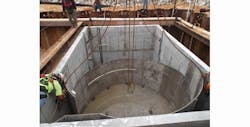Precast Power
The Mississippi State Port Authority invested nearly $60 million to extend and deepen the Port of Gulfport. As part of the 60-acre expansion, vortex swirl chambers were installed to filter out waste, oil and sediment from storm water before it is released into the Mississippi Sound. Each of the 14 swirl chambers is contained within precast concrete structures measuring 12 ft tall and weighing 250,000 lb.
By using precast, the project owner saved both time and money during installation. Aside from having high strength and an extended service life, the main reason the underground precast storm water treatment structures were specified was time constraint. Due to the project’s location on the water and the complexity of the port expansion, excavation and installation needed to be completed in a matter of days. As such, casting in place was not possible. The solution also increased safety.
Four boxes were installed at a time, set close to one another: two large 15-ft-by-22-ft pieces with 8-ft-by-10-ft structures in between them. All boxes were tied together with pipe to make the storm water loop.
Further to the north in Tennessee, a local fire chief sought to reduce his city’s water expenses by harvesting rainwater to use for the facility’s training exercises. The chief wanted a rechargeable system that would hold rainwater to irrigate the grounds and supply hoses for training exercises. This type of system allows the fire department to use less city water, providing both environmental advantages and cost savings.
Frustrated by the performance of other materials, he turned to a watertight solution that would function exactly as desired. A local precaster supplied five precast concrete utility vaults measuring 9 ft on all sides for the project. Collectively, the vaults—which were installed in one day—hold nearly 30,000 gal of rainwater.
Local residents will continue to benefit from the stored rainwater directly and indirectly for years to come.
To learn more about both of these projects, read the full case study here.


